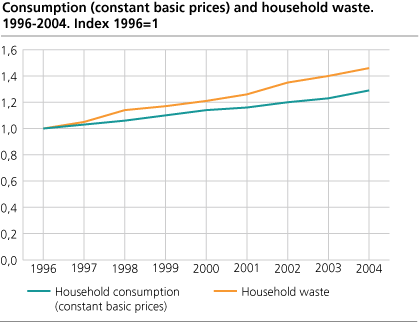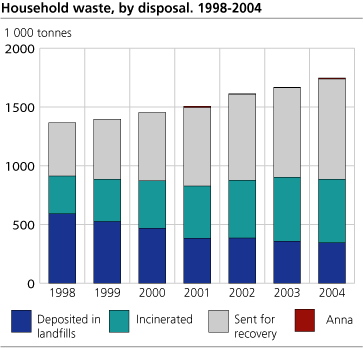Content
Published:
This is an archived release.
Half of all household waste is being sorted
Half of the total amount of household waste was sorted and sent to recovery plants in 2004. The amount of household waste is increasing, and so is the proportion that goes to recovery. From 2003 to 2004 the amount of household waste generated increased by 76 000 tonnes. In 2004, 90 000 tonnes more household waste was sorted and sent to recovery than in 2003.
In total, 1.74 million tonnes of household waste was collected in 2004, of which 49 per cent was sorted and sent to recovery plants. This equals 854 000 tonnes, compared with 46 per cent in 2003.
Waste and consumption
The figures show that household waste generation increased by 4.5 per cent from 2003 to 2004. This is almost equal to the increase in household consumption, measured in NOK. Last year every Norwegian generated an average 378 kilos of household waste - 13 kilos more than in 2003 and 100 kilos more than in 1997. The figures do not include discarded vehicles and other waste not covered by the municipal waste collection services.
|
Household waste. Total amunts and recovery.
1992-2003. Tonnes and kg per inhabitant |
| The whole country | Total | Sent for recovery | |||||||||||||||||||||||||||||||||||||
|---|---|---|---|---|---|---|---|---|---|---|---|---|---|---|---|---|---|---|---|---|---|---|---|---|---|---|---|---|---|---|---|---|---|---|---|---|---|---|---|
| Total |
Kg per
inhabitant |
Total |
Kg per
inhabitant |
||||||||||||||||||||||||||||||||||||
| 19921 | 1 012 192 | 237 | 86 363 | 20 | |||||||||||||||||||||||||||||||||||
| 19951 | 1 173 643 | 269 | 212 689 | 49 | |||||||||||||||||||||||||||||||||||
| 19961 | 1 195 274 | 274 | 260 234 | 60 | |||||||||||||||||||||||||||||||||||
| 19971 | 1 259 333 | 287 | 365 898 | 83 | |||||||||||||||||||||||||||||||||||
| 1998 | 1 363 909 | 309 | 452 698 | 102 | |||||||||||||||||||||||||||||||||||
| 1999 | 1 396 674 | 314 | 524 156 | 118 | |||||||||||||||||||||||||||||||||||
| 2000 | 1 451 590 | 324 | 581 056 | 130 | |||||||||||||||||||||||||||||||||||
| 2001 | 1 506 715 | 335 | 668 393 | 148 | |||||||||||||||||||||||||||||||||||
| 2002 | 1 612 674 | 354 | 731 632 | 161 | |||||||||||||||||||||||||||||||||||
| 2003 | 1 670 602 | 365 | 764 347 | 167 | |||||||||||||||||||||||||||||||||||
| 2004 | 1 746 353 | 378 | 854 338 | 185 | |||||||||||||||||||||||||||||||||||
| 1 |
The figures are scaled down to correct for interference of waste
from the industries. |
| Source: Waste statistics, Statistics Norway. | |
More waste is sorted
A total of 854 000 tonnes of household waste was sorted and sent to recovery in 2004. This is a 12 per cent increase compared with 2003. On average every Norwegian sorted 185 kilos of waste in 2004 compared with 167 in 2003.
In this context, sorted and sent to recovery means that the waste is pre-sorted in the household or at waste disposal plants. After the waste is sorted it is normally recycled, composted or incinerated for energy utilisation, but residues from sorting are in most cases disposed of in landfills.
Less goes to final disposal
The amount of household waste that goes to final disposal has fallen by 2 per cent compared with 2003. Around 345 000 tonnes of household waste was sent to landfills. In 2004, around 539 000 tonnes of household waste was incinerated, a decrease of 1 per cent since 2003.
The figures are compiled from a census conducted by Statistics Norway in all Norwegian municipalities and inter-municipal waste management companies (excluding Svalbard). The figures are preliminary.
or go to:
Statistics Norway, Waste statistics
Statistics Norway, Waste accounts
Tables:
- Table 1 Household waste, by county and municipality. Percentage waste sent for recovery, including energy recovery. 1995, 1998, 2001, 2002, 2003 and 2004
- Table 2 Household waste sent for recovery, by material and county. 1992-2004. Tonnes
- Table 3 Household waste, by disposal and county. 1992-2004. 1 000 tonnes
- Table 4 Percentage of inhabitants living in municipalities offering collection at home of sorted waste fractions. 2004
- Table 5 Sorted for recovery and mixed waste, by disposal. 2004. 1 000 tonnes and per cent
Contact
-
Camilla Skjerpen
E-mail: camilla.skjerpen@ssb.no
tel.: (+47) 48 22 72 14
-
Mona E. Onstad
E-mail: mona.onstad@ssb.no
tel.: (+47) 48 59 61 86


